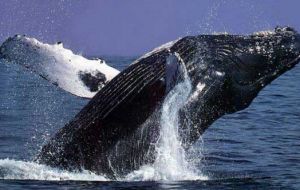MercoPress. South Atlantic News Agency
Chilean scientists to record blue whales “conversations”
 Scientists record whale conversations
Scientists record whale conversations Marine Biologists from Chile's Blue Whale Center (CBA) have embarked on a new project to record the noises made by endangered blue whales off the coast of southern Chile. They hope to use their recordings to identify individual whales and learn more about how whales communicate with each other.
Using special buoys fitted with underwater microphones (hydrophones) CBA scientists will record and study the "conversations" between the large blue whale population in waters around the southern island of Chiloé (Region XI). Each whale has an individual "voice," similar to a human fingerprint, which enables it to be distinguished from other whales. Scientists hope that this method of identification will be more accurate than the photographic system they currently use. "We'll be able to identify certain behaviour through this work," said Maximiliano Bello from the CBA. "We can study interaction between the males and females, and between parents and offspring. We can look at the sound frequency when they find food or when they're annoyed or in pain." The blue whale has one of the most powerful voices of the whole animal kingdom, transmitting noises of 190 decibels â€" the equivalent of a Boeing 747 taking off - which carry for thousands of kilometres under the sea. The hydrophones are specially designed to pick up the whales' low-frequency sounds. "With the recordings we receive from the hydrophones - which get transmitted directly to a computer - we will have a huge amount of information to learn about how the whales arrive at this zone," said CBA director, Rodrigo Hucke-Gaete. "This acoustic data will enable us to identify separate populations because there are probably different dialects between different blue whale groups". Blue whales are down to just 1% of their original population in Antarctic waters. Every summer, from January to April, over one hundred blue whales migrate to the Gulf of Corcovado, south of Chiloé, to feed and nurse their young. The mix of fresh river water with the sea makes the area a prime location for the blue whale's main food source â€" krill. In 2003 alone Hucke-Gaete's research team spotted over 150 of the endangered marine mammals - most notably, eleven mothers with their calves. The CBA is now campaigning for the establishment of a multiple-use protected marine area centred on the gulf. The plan would promote further scientific research on the area, foster environmental education in adjacent communities, and regulate commercial use of the waters. The sanctuary is still awaiting government approval. The giant mammals inhabiting the area are still under threat from whaling. The Kyodo Senpaku company hunts whales in the Corcovado Gulf under a license for "scientific whaling" issued by the Fisheries Agency of Japan. Despite killing endangered species in the name of science, the majority of the company's hauls will end up on people's plates. The Japanese government will allow 945 whales to be caught this year. Greenpeace ship La Esperanza is currently patrolling the same waters in the hope of coming between the whaling ship and its prey. The Santiago Times -




Top Comments
Disclaimer & comment rulesCommenting for this story is now closed.
If you have a Facebook account, become a fan and comment on our Facebook Page!